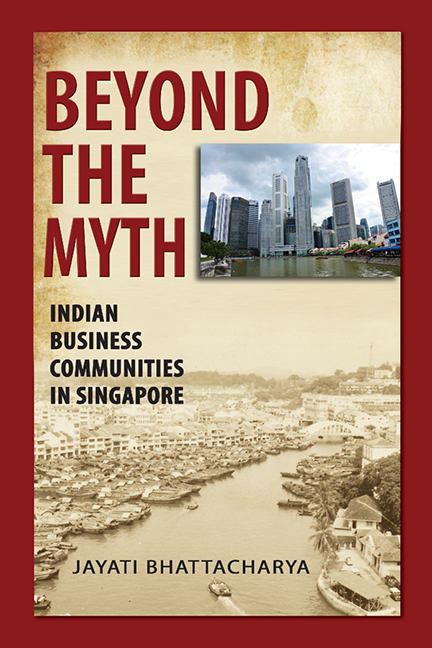Book contents
- Frontmatter
- Dedication
- Contents
- List of Map, Tables and Figures
- Message by Mr R. Narayanmohan
- Foreword by Professor Tan Tai Yong
- Message by Ambassador K. Kesavapany
- Acknowledgements
- List of Abbreviations
- Introduction
- PART ONE
- Chapter One Making Singapore their Homeland: The Early Indian Migrants to the Lion City
- Chapter Two The Post-Independence Period: Changing Dynamics and the Shift in Business Activities
- Chapter Three Taking Strides into the Future: Transition and Transformation of the Indian Business Communities
- PART TWO
- Conclusion: Surging Forward
- Appendices
- Select Bibliography
- Index
- About the Author
Chapter One - Making Singapore their Homeland: The Early Indian Migrants to the Lion City
from PART ONE
Published online by Cambridge University Press: 21 October 2015
- Frontmatter
- Dedication
- Contents
- List of Map, Tables and Figures
- Message by Mr R. Narayanmohan
- Foreword by Professor Tan Tai Yong
- Message by Ambassador K. Kesavapany
- Acknowledgements
- List of Abbreviations
- Introduction
- PART ONE
- Chapter One Making Singapore their Homeland: The Early Indian Migrants to the Lion City
- Chapter Two The Post-Independence Period: Changing Dynamics and the Shift in Business Activities
- Chapter Three Taking Strides into the Future: Transition and Transformation of the Indian Business Communities
- PART TWO
- Conclusion: Surging Forward
- Appendices
- Select Bibliography
- Index
- About the Author
Summary
The geostrategic importance of the Indian Ocean has continued from ancient times and still flourishes as one of the pertinent theatres for complex maritime trading systems. Singapore, with its unique geopolitical entity, has gradually assumed centre stage in the historical evolution as a centre for commerce, trade, entrepot and other maritime and political activities. The Indian subcontinent, on the other hand, has also been successful in exploiting the favourable geographical location in the heart of the Indian Ocean for a much longer period of time. The Indian Ocean gradually came to be dominated by Western naval suitors in the seventeenth and eighteenth century onwards. The Portuguese extended their maritime expansion with state patronage and soon had to face other contenders in the British, French and Dutch naval powers. The reigning phase of colonialism leading to imperialism made the Western powers very ambitious and the Asian states more and more vulnerable, ultimately resulting in the extensive prowess of the former, especially the British.
Centuries of maritime trade connectivities encouraged mobilization and migration of trading communities and others to different parts of Asia and beyond. As historian K.N. Chaudhuri writes, “There is every reason to believe that pre-historic movements and migrations of people took place both by sea and land.”2 Indian communities, being no exception to the rule, had travelled and migrated to different nooks and corners of Asia and beyond. The onset of British imperialism consolidated and facilitated greater movements of goods and people to cater to their administrative, military and commercial interests.
THE ADVENT OF COLONIALISM AND INDIAN MIGRATION
Stamford Raffles arrived in Singapore in January 1819 and opened the colonial chapter of a long established linkage, and globalization in Asia came to be redefined with a new rhetoric. Singapore became the key strategic location between Calcutta and Canton in the eastern trade routes of the British. It was an anchoring ground for a wide variety of sea vessels from the Chinese junks, Indian ships, Arab dhows and Portuguese battleships.
- Type
- Chapter
- Information
- Beyond the MythIndian Business Communities in Singapore, pp. 23 - 90Publisher: ISEAS–Yusof Ishak InstitutePrint publication year: 2011

